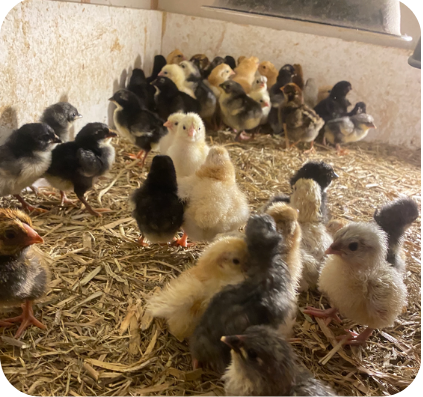5 Things You Should Know Before Buying a Rabbit – Safe and Effective Rabbit Care
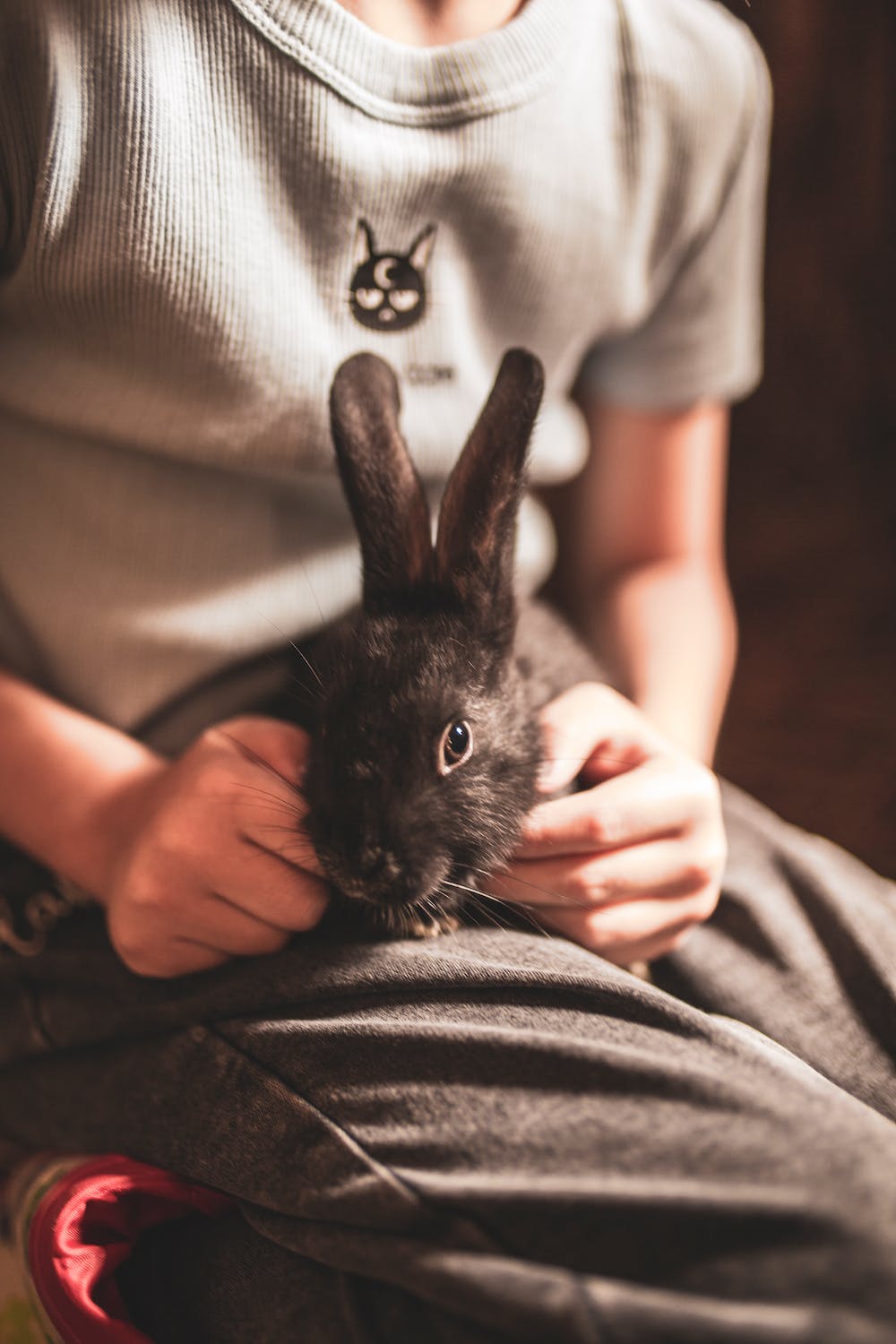
Published
5 Sep 2023Estimated Time
2023 is the Chinese year of the rabbit! So were 1975, 1987, 1990 and 2011. The rabbit symbolises mercy, elegance, beauty, fertility, luck and creativity. In the spirit of our rabbit year and our love for bunnies, let’s dive into rabbits and how to care for them.
In 2022 rabbits held 3rd place for 15 years as the most popular pet in the US. They’re currently sitting in 4th place in Australia. Rabbits are hugely underestimated.
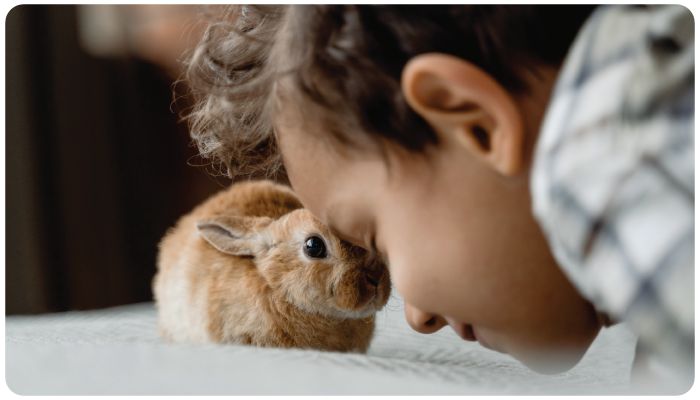
Also, rabbits are very trainable just like dogs. Read on to understand how easy it is with a little persistence to train your house-dwelling rabbit not to chew cords, to use a litter tray and even do tricks like fetch, with our safe and effective rabbit care training tips.
Experienced pet rabbit owners know well they can be spontaneous, affectionate and full of personality. Imagine the look on your friends’ faces when they come over for a visit and you show them how your rabbit can fetch a stick. Classic.
YouChoose Pets and Livestock wants to empower people just like you take care of their pets safely and effectively. Also, minimise the vet visits!
The YouChoose Pets and Livestock team have over 60 years of experience combined in taking care of a range of pets and livestock. From dogs, and ferrets to rabbits as well as geese to cattle. We know and love animals.
Join Our Mailing List
Stay connected with us for regular updates from us 1-2 times per month, packed with valuable insights and tips like the YouChoose Animal showcase and trialled and tested best practices for raising your animals.

"*" indicates required fields
By signing up you are agreeing to our Terms of Service and Privacy Policy
The American Rabbit Breeders Association (ARBA) officially recognises over 50 breeds of rabbits (Moore, 2005)2. This article has been created with Satin, Mini Lop, Rex, Dwarf and Dutch rabbits in mind. The five top breeds in Australia. How to care for each breed will of course vary slightly. We recommend doing research specifically on the breed you are interested in.
So, let’s get started on tips for safe and effective rabbit care.
Rabbits don’t like to be picked up.
My eight-year-old nephew was sad when he learnt this. “You mean I can’t pick up the cute cuddly little rabbit?”
Yes, that’s right – rabbits don’t like being scooped up and cuddled by people who they don’t know and most of the time even their owners.
Rabbits are prey animals – being scoped up constantly can freak them out. They think it’s an eagle scooping them up for breakfast. It sends them into survival mode.
Notice their eyes looking scared next time someone picks up your rabbit no matter how well-intentioned.
When your rabbit wants attention it will let you know. It’s usually very subtle, for instance, it sits closer than normal to you or a little nose nudge on your foot.
As you get to know your rabbit you will become accustomed to their subtleties for wanting attention. Even then they probably just want a scratch behind the ears or a gentle head pat.
Other Ways To Bond With Your Bunny
- Get down to their level – Grab a pillow lay on the ground and let your rabbit come to you.
Let them sniff you then slowly move in to see if they want a head pat. Let them see your hand coming. Keep it slow and relaxed.
- Regularly hand feed them – Make it part of their daily feeding routine. Grab their favourite lettuce scoop a few bits at a time out and watch then chow down.
Trying other ways to bond with your bunny without picking them up will increase their trust in you. You will start to notice more and more that they will look for more affection from you. I’ve heard of some bunnies jumping into bed for morning pats.
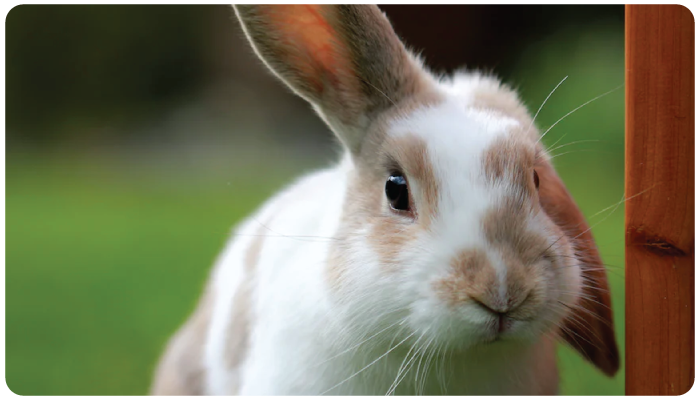
Some fruits and vegetables can be harmful and even toxic For Your Rabbit.
A well-balanced diet is essential for your rabbits’ health and well-being. Let’s take a brief look at what types of food rabbits can be given and the recommended frequency.
Fresh vegetables play a key role in a domestic rabbit’s diet. They provide nutrients not found in pellets and hay (Moore, 2005)2. When introducing a new vegetable, introduce it slowly then monitor your rabbit in case of any digestive issues.
A list of vegetables that can be fed frequently.
- Beet greens
- Cilantro
- Swiss chard
- Romaine lettuce
- Dandelion greens
- Endivine leaf
A list of vegetables that should be never fed.
- Sweet corn
- Potatoes
- Rhubarb leaves
- Raw beans
- Onions
It’s also recommended not to feed your rabbit vegetables that look like they are about to spoil. They can cause digestive upset.
Always wash and dry the vegetables. Other than vegetables high-quality hay and pellets in small quantities are good to keep up a varied diet. Hay and pellets aren’t a staple part of the diet but are good supplements.
Alfa-based hays are high in nutrients such as protein and calcium. If you’re feeding your rabbit pellets and hay makes sure only one of them is alfa based. Too much alfa can cause digestive issues (Moore, 2005)1.
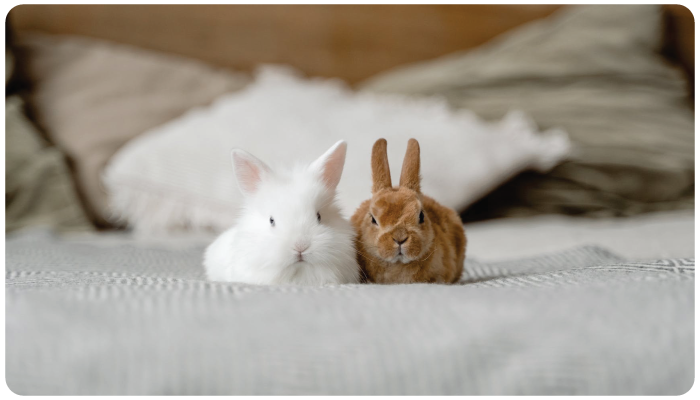
You can teach your Pet Rabbit some pretty cool and effective rabbit care tricks.
There are SO many tricks you can teach your rabbit. A YouTube clip recently went viral of a guy who taught his pet rabbit, Bini to play basketball. Bini has a mini basketball hoop and his specialty is slam dunks. Pretty cool!
Some good tricks to start with, with your rabbit, are
- Spin
- High Five
- Jump
- Fetch
Use treats to teach them like berries cut in half or goji berries. Treats used for rabbits need to be small. Especially when you first start out teaching them tricks. You need to be able to give them a few but not overload them with sugar. Rabbits should be fed very small amounts of fruits at a time to prevent sugar overload.
They are nothing like a dog or a cat. Not even close.
There are some slight overlaps in characteristics. But overall they’re not really like any other animal in particular. They’re probably more like cats if any.
Like a cat, rabbits are clean, curious and self-groomers. Also at times can be just as affectionate and super clumsy as dogs.
But there’s one major difference which is what sets them apart. In the animal kingdom food chain, they’re pretty much everyone’s dinner. For this reason, rabbits need to be treated VERY differently (Moore, 2005)1.
They’re not as obedient as dogs. Rabbits are timid but loving animals. You need to be patient and as consistent as you can with them and their training.
Some rabbits can take months to get the hang of the training.
It will pay off in the end – promise.
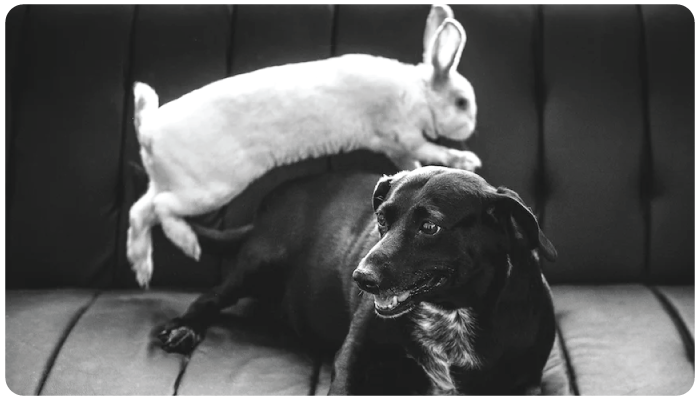
Train your Rabbit to come when you call its name.
Yes – this is very much possible. Over time rabbits can understand human language. If you have a bond with your rabbit training will be much easier too.
Always try to create an ongoing positive and calm environment for your rabbit and for all pets. This way they are more likely to respond better to you and your commands.
Rabbits can do more than most people think and are loads of fun. However, it’s important to understand Rabbits are not dogs.
Dogs are hunting animals and rabbits are prey animals, which makes them fundamentally different in many ways. Training can take longer but if you are persistent with your rabbit it will pay off.
How to Train Your Bunny
Pick a high-valued treat – goji berries work well. You can always run a test and offer different treats and see what they like best.
Sit close or next to your rabbit. Say their name and use the treat to entice them. Then as soon as they are closer to reaching for the treat give it to them.
The goal is to teach them to associate their name with the treat.
It doesn’t need to be their name that you use. You can use other words like come. Whatever word you decide on keep it short like 1-2 syllables.
Once your rabbit has got the hang of this start doing it from further away. Again once they have the hang of that distance try it even further away. A separate room if you can.
Try this 5-10 minutes at a time a few times a week for 3-4 weeks.
The entire process may take a few months.
Once you feel confident they have got the complete hang of it start phasing out the treats. Not completely just not every time they come to their name. Change it to sometimes to maintain the habit.
It’s all about repetition and positive reinforcement. You’re conditioning the behaviour slowly over time. Be mindful of how you say the command. Paying attention to your inflection, pitch and speed. Keep it consistent each time you say it.
You can free roam and house train your rabbit. It’s easier than you think.
I know what you are thinking. What about their poo, what about chewing power cords and chewing just about anything.
Let’s start with toilet training and then move to **chewing**.
Rabbits can be litter trained just like dogs and cats. The hooded or enclosed litter trays are a great option.
Rabbits like to kick and scratch in their litter. Having an enclosed one will create less mess for you. Also, being enclosed keeps your home looking neater.
Rabbits do normally gravitate to doing their business in one spot too. Very handy! If this is the case put the litter tray in this spot.
If you cannot put the litter tray in this spot or your rabbit is having accidents everywhere. Clean up the accidents and put them into the litter tray.
For instance, once you have wiped up their pee put the paper towel in the litter. They need to get accustomed to the smell of their poo and wees coming from the litter.
Thoroughly clean up any mess and smells not in the litter so the smell is coming from one place.
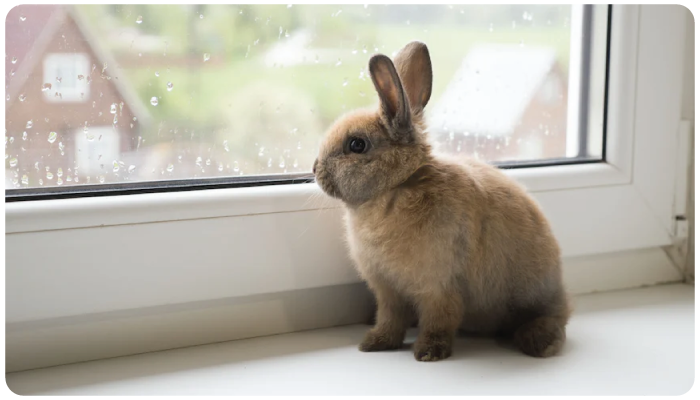
Now for the Cords
With some persistence, training your rabbit not to chew cords or at least minimising the chewing damage around the house can happen pretty quickly.
Relocate any cords you can. Put them up so your rabbit can’t get to them.
Ok, some cords and other items they like to chew such as furniture can’t be relocated – what about them?
Ideally, you need to catch them in the act. And we promise you will. When you do make a loud noise like banging on the wall near them and say NO in a stern voice. You may need to do this a few times.
If this doesn’t work scoop them up whilst in the act, hold them up and say NO again.
The last option if they are still not listening is to place them in time out. This could be in their hutch or a penned-off area with little to do.
Rabbits chew things because their teeth are constantly growing. They need a way to work them down. Non-toxic sticks like appletree sticks and bamboo are good substitutes for cords and furniture.
Place these sticks around the house where your rabbit likes to dwell. Such as under couches or behind the bed. That way when your rabbit needs to do some chewing the sticks will be easily accessible for them.
Is a Free-Roaming House Bunny for You?
If you are not a dog or cat person but need a little more stimulation than what fish can provide try a house bunny.
There is much more to learn about free-roaming house bunnies. This article touched on a few major points.
There are loads of great Youtube videos on how to train and care for your bunny and how to integrate them into your household. We do recommend watching a few of these videos before buying one. Just to be sure a rabbit is the best fit for you, your home and your lifestyle.
Seeing as they are timid animals and more fragile than cats and dogs, rabbits are not the most ideal animals for young children. Children aged 10 or above who love animals could be an ideal fit.
With the right care and consistent training, bunnies can be just as fun as a well-trained house puppy.
Citations
- Moore, L. C. (2022). A House Rabbit Primer, 2nd Edition: Understanding and Caring for Your Companion Rabbit. In Google Books. Santa Monica Press. ouse_Rabbit_Primer_2nd_Edition.html?id=96V9EAAAQBAJ&redir_esc=y

